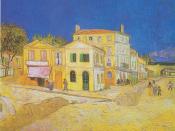Cypresses
Van Gogh's "Le Cypres" or, in English, Cypresses, was painted in 1889. It shows two cypress trees, on a sunny landscape of grass, rolling hills, mountains, and a clear blue sky. These trees are overbearing, large, dark and almost scary and intimidating, however this painting is a very beloved one. It evokes feelings of danger, power and turmoil, but the bright background makes it human and beautiful.
Van Gogh uses large, thick brush strokes to illustrate the swirling leaves of the cypresses. The paint is so thick that clots remain on the canvas. The trees, although they are green, have hints of black in them, which evoke feelings of hidden dangers. The trees, with the twirling brush strokes seem to be in motion, giving the painting a feeling of movement. The trees seem to be made of indefinite shapes, however, it is easy to tell where one leaf ends and another begins.
There is a rhythm to the shapes. Everything on the canvas seems to have a texture, a life of its own.
These tumultuous trees are painted against a beautiful, countryside. The grass is overgrown, and seems to be blowing in the wind. The mountains in the background are purple and blue, and seem to be far away and very harmless. The sky is bright blue and clear, and although the swirling strokes give the illusion of wind, it seems to be a calm day. There is either a sun or moon out, that is providing light to everything below it.
Van Gogh often paints scenes that place danger on safety, fear on comfort, turmoil and tragedy on happiness. He thrives on this contrast. In this painting, the trees provide the danger to the serene, peaceful scene. In addition, the shapes of the cypresses seem to evoke a...



This is the author
To Vikingwrstlr-
Field of Cypresses, or actually, Cypresses in a Wheat Field, is a different painting, however, both were done by Van Gogh.
9 out of 9 people found this comment useful.